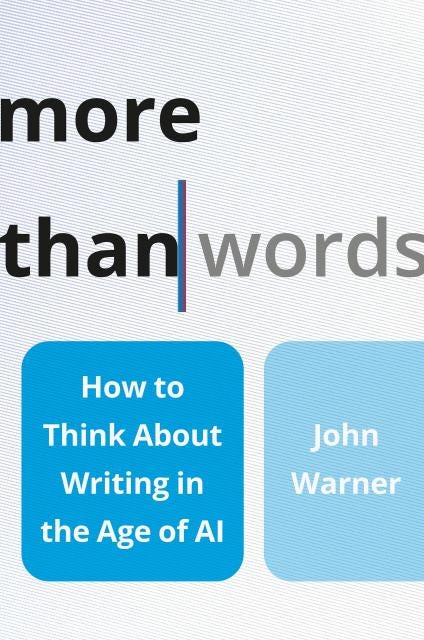Book Review: More than Words
A review of John Warner's timely and essential playbook for writing, post-ChatGPT
The first time I heard about ChatGPT was from a mutual friend in academic philosophy, via Facebook. I went to OpenAI’s website and played around with the LLM for a few minutes. It didn’t take long to come to the conclusion that this technology would be more revolutionary (in the full meaning of that term) than any text-producing mechanism since the printing press. As an educator, I knew it would be especially disruptive. Two days later I received my first piece of work from a student that had been fully generated by AI. I’ve dealt with multiple such instances of academic dishonesty since, and I suspect the rate of adoption amongst my students has gone up in the last year as detection software has begun to lag in its usefulness.
As someone who primarily teaches rhetoric (a weird mix of philosophy, writing, and speaking), I’ve thought almost nonstop over the last two and a half years about this technology and how to teach students to reason, feel, write, and speak to an audience when they can punt much of the work to a syntax-generator. It’s hard not to be anxious, especially as advances in the development of generative-AIs proceed at a pace that consistently outstrips what we’re able to respond to in schools and it’s clear that the adoption of AI by students is gaining rapid strides. The general sensation is of being submurged by a flood, with no one around to come to the rescue. We’re going to need to build our own raft.
’s book appears as a welcome flotation device, something to grab onto to provide some increased bouyancy. It does this by way of insight and clarity. The book is divided into parts. Part one sets conceptual ground rules for what genAI is. Part two in turn deals with what writing and reading really are, something most people have never thought about despite knowing how to accomplish these tasks at some level of proficiency. Part three is a bit of a grab bag, but deals with the more immediate impacts of genAI on writing, focusing on a variety of particular, salient contexts: teaching writing, the culture of the internet, and writing for pay. Finally, Warner concludes with a four-part framework for thinking about how to incorporate AI into our lives as writers and readers without giving into the inevitability arguments offered up by the tech billionaires who want us to adopt it wholesale.This book is good, and I’m deeply grateful to Warner for writing it. One of his persistent worries throughout the text is that it will be dated. This is obviously a problem for anyone writing a book about an emerging technology. While Warner’s attempt to stave off that worry—by focusing largely on developing an enduring conceptual framework for what AI and writing are, and how we should engage with the technology in broad strokes—should be fairly successful, it’s inevitable that the book will be dated in some sections. For example, there are some reflections about his early experience of AI, similar to my opening paragraphs here. It would be weird not to include these in a book published in 2024. They’ll be dated by 2030. But this is fine. Some pieces of writing are important as time capsules, and some of the parts doomed to be dated are really helpful now—a recounting of an experience of trying to create an AI-doppleganger, an insightful passage about the state of Substack in the media landscape circa 2024, some reporting about what Khan Academy and others are trying to force in education in the early days of AI. These are all helpful now and should still serve as interesting recent history to future readers.1
There are a number of beneficial insights, well-articulated throughout the book. I’ll highlight two of my favorites here. Warner really presses on the way tech bros anthropomorphize (and we tend to passively accept) the language of what AI does. We say that it writes, or that it’s thinking (say, when we’re waiting for it to finish generating some text). Even the name “artificial intelligence” gives away too much. I’m condensing a lot of carefully argued work in the book, but the simple way of articulating the point is that AI doesn’t have a mind, so it can’t be said to think or feel (or anything else that requires cognition or consciousness). It’s not intelligent. When we’re talking about LLMs we’re just talking about syntax-generators. Writing, by contrast, requires thinking and feeling, contends Warner. By a straightforward syllogism, you come to the conclusion that AI doesn’t write. (The point would stand for other forms of genAI: creating art requires thinking or feeling; AI doesn’t think or feel; so, AI image-generators don’t create art.) This, I agree with Warner, is important. It’s important to recognize and to resist language that allows too much cognitive power to LLMs and the like.
When it comes to what to do now, Warner’s framework is both clear and nuanced enough to be helpful. The three-part framework is Resist, Renew, Explore. Without going into the details here, Warner’s sensibility is to resist passively accepting the idea that wholesale adoption of genAI into all parts of life is inevitable, an argument that’s most commonly adopted by the people who stand to gain financially from its adoption. Rather, we should seek ways to retain and restore what’s most human and communally empowering about our reading and writing practices, only seeking to explore means of incorporating the technology into our lives when we have a clear sense of what meaningful would be lost were it to be replaced. This approach to technology has more in common with the Amish and the Luddites (both misunderstood in their approaches to tech) than it does with our usual approach in urban America, which is to say it’s slower and more human and sane.
As both a writer and educator, I benefitted from reading Warner’s book. His insight into the nature of writing as thinking and feeling was deeply meaningful to me, and something I think will help me as I continue to impart the meaningfulness of writing projects to my students. I’m sure I would differ with Warner about some of the minutiae of classroom implementation of his ideas, but the virtue of this book is that at a time when the tech companies are disrupting education at a rate faster than educators can adapt to, the book stays at the level of framework that will foster broader agreement while still remaining useful into the future.
The fundamental idea underlying all of Warner’s work in this book is that writing and reading are intrinsically linked human activities. Writing is a form of joined thinking and feeling that a person does, thereby making that act of thinking and feeling (indeed, those very thoughts and emotions) accessible to another person. Those activities are really something special. I’m writing this from a bookshop in Athens right now, as I watch and listen to people speak to each other and read books in a dozen different languages and partake in these very human forms of communion in the most ancient city I’ve ever visited. I feel the point keenly. Thank you articulating it, John!

I am a full time high school educator and parent. In order to do the writing I do here, I work on this publication between 4:00-5:00am most days. I write because I love to, and I won’t put a paywall up on my work. If you appreciate what you’ve read, it would encourage me if you left a note or shared it with a friend. If you’d like to show appreciation with monetary support, please consider giving to my church’s second building fund by clicking below, selecting “Give to Second Campus,” and entering an amount.
I recently read Nicholas Carr’s The Shallows and had this experience. He is reporting on events that are current at the time, events I had lived through, but the experience of reading about them 15 years later with the benefit of hindsight was fascinating and enjoyable.





